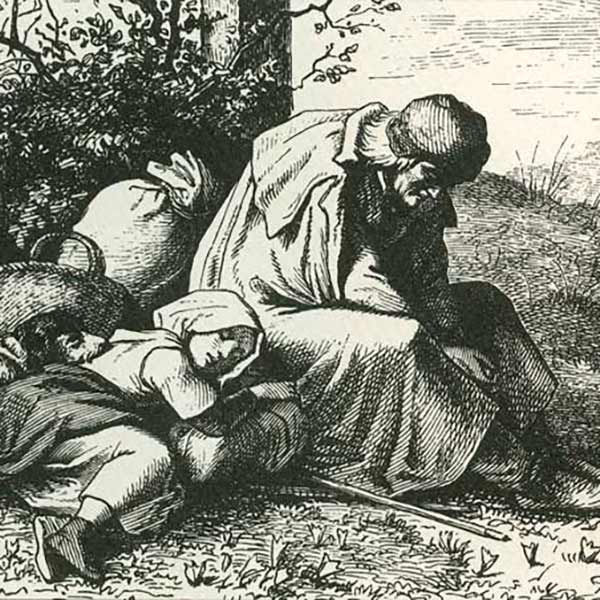Subtotal: $
Checkout
Jakob died 1536, in Innsbruck, Austria, and
Katharina in 1538, in Schöneck (modern Italy)
It is not known when Jakob Hutter, a hat maker from the rugged Alpine valleys of Tyrol who may well have taken part in the peasants’ revolt of 1525, first encountered the nonviolent teachings of the “dangerous” Anabaptists. The Anabaptists taught that the Roman Catholic Church had strayed from the original teachings of Christ. Their rejection of infant baptism, and promotion of adult baptism as a sign of voluntary discipleship, quickly made them a target of fierce persecution, not only from the Catholic Church but from Protestant groups as well.
Embracing the Anabaptist teachings with conviction, Jakob Hutter became a zealous convert. After Georg Blaurock, the last of the founders of the movement, was burned at the stake in September 1529, Jakob spearheaded the mission in Tyrol, teaching, baptizing, and helping new believers form Anabaptist congregations. In 1531 he baptized Katharina Purst, a young servant girl who later became his wife.
With Jakob’s entrance into ministry, Anabaptist groups in Tyrol found a leader to galvanize them in the face of growing persecution. His leadership and his emphasis on the communal nature of the church began to unite the growing movement. Converts pooled their money and possessions in a common treasury, in keeping with the early Christians’ example. Although his accusers would later claim that he baptized for money, the common purse drew groups of Anabaptist believers closely together and provided for those in need.
The ruling powers now felt threatened not just by new religious teachings, but by this radical economic model of sharing. Travelling and teaching throughout the Tyrol region, Jakob quickly drew their attention. Ferdinand I, the king of Bohemia, Hungary, and Croatia, was openly antagonistic toward this upstart movement of “heretics,” whose beliefs challenged the cozy marriage of the Catholic Church and the state. A pious Catholic, Ferdinand considered himself a defender of the faith against the growing number of Protestants in his land, in particular the widely-hated Anabaptists.
Persecution on a systemic scale was inevitable, and when it came, it was brutal. In one report to Ferdinand, it was said of the Anabaptists that “more than seven hundred persons have been in part executed, in part expelled, in part have fled into misery, who left their property as well as their children behind.”
The ruling powers felt threatened not just by new religious teachings, but by a radical economic model of sharing.
Moravia (in today’s Czech Republic) had a tradition of religious tolerance, and Anabaptists from all over Europe were converging there. The church in Tyrol sent Jakob with a companion to find out what the situation there was. He was thrilled to find believers living together in full community in the town of Austerlitz. The Chronicle, an early history of the movement, reports: “They found that both groups were of one heart and soul in serving and fearing God. Thereupon Jakob [and his] companions, in the name of the whole church, united in peace with the church at Austerlitz.” They then returned to the work in Tyrol.
By 1533, the intense persecution had made it nearly impossible for Anabaptists to remain in Tyrol. , betrayed, hunted down, and seized by the police. Jakob Hutter was particularly targeted for his zealous missionary activity, but he managed to evade the authorities. The clergy worked hand in glove with government officials. As one account put it, “The priests, too, thundered from their pulpits that the people should watch out for them, seize them, and destroy them by fire and the sword.”
The authorities turned people against one another, promising informers monetary rewards. Spying became rampant. More and more Anabaptists fled to Moravia. Some made it without major incident, but many were arrested along the way, tortured, and sometimes executed. Jakob heard reports of some believers whose cheeks had been burned through before being released. One immigrant, Peter Voit, was captured and imprisoned in Eggenburg. His jailers clamped his legs so tightly in the stocks that gangrene set in. Voit watched in horror as mice took the toes from his feet. When he was finally released, both his legs had to be amputated. Despite these afflictions, Voit survived the persecution and lived to an old age.
Jakob Hutter returned to Moravia in August 1533. Here he encountered opposition from within the movement as well as from without, as some of the leaders resisted his spiritual authority. They slandered Jakob’s followers, even refusing to eat with them or greet them in passing on the street. But Jakob was able to expose the lies and eventually lead the diverse group to become a unified church.
Meanwhile, the city of Münster was taken over by a fanatical branch of Anabaptism under a tailor from Holland named Jan van Leyden. Like Jakob Hutter, he used scripture to argue that only adult believers should be baptized and established community of goods. But while other Anabaptists refused to use physical violence, even in self-defense, the followers of Jan van Leyden had no such qualms. They drove out citizens of Münster who would not be rebaptized and seized control of the city government. However, Münster was soon retaken, and van Leyden was captured along with two of his companions. The three were tortured with hot tongs and then executed, their bodies hung in iron baskets from the highest tower in Münster.
Jakob was able to lead the diverse group of Anabaptists to become a unified church.
used this revolution as a pretext to drive the Anabaptists from Moravia. Though they denied any connection with the Münsterites and condemned their actions and practices, the local authorities conflated the two groups, and many were imprisoned and tortured. In 1535, Moravia granted Ferdinand’s request and banned all Anabaptists from the country.
Meanwhile, Jakob’s group had decided to stop working as laborers in any way that benefited the Catholic Church, viewing such actions as funding idolatry. When they refused to work the vineyards of an abbess who had let them settle on her lands in Auspitz, she was outraged and forcibly evicted them. Due to Ferdinand’s decree, they could find nowhere to settle and were forced into a nomadic lifestyle, wandering through fields and hills.
At one encampment someone reported them to the authorities, accusing them of carrying weapons. When the governor’s men reached the camp they found no weapons, but many children and sick people. Jakob explained their situation, pleading with them to leave his followers alone. The deputation told him that he needed to make his case to the governor in writing. But when the governor received Jakob’s strongly worded letter, he directed his servants to immediately return and arrest him. Although Jakob once again escaped, two of the group were arrested, racked, burned, and questioned under torture about money and supplies their group was thought to be hiding. One of them recanted under torture. The other was burned alive.

Already a subscriber? Sign in
Try 3 months of unlimited access. Start your FREE TRIAL today. Cancel anytime.
After this, the community decided that it was no longer safe for Jakob to remain with them. They unanimously voted that he should return to Tyrol to gather the remaining Anabaptists. Before he left, he placed a man named Hans Amon in charge of the group. Then, Jakob and his wife, Katharina, began the dangerous journey back to the Tyrol.
Jakob wrote several letters to the church in Moravia, encouraging them and telling them of his work in Tyrol, where he taught and baptized despite intense persecution. In his final letter, Jakob wrote, “In our hearts there is great pain and sorrow for your sake, and outwardly we, too, are suffering severe persecution. The horrible, raging dragon has opened its jaws wide to devour the woman robed with the sun, who is the church and the bride of Jesus Christ.”
Finally, on November 29, 1535, Jakob and Katharina were captured and the two were separated, never to see each other again in life. Jakob was gagged and taken to the city of Innsbruck, where King Ferdinand’s government resided.
Though a theologian was brought in to try to convert Jakob and prove him wrong with scripture, his attempts were fruitless. Jakob adhered steadfastly to his Anabaptist beliefs. Besides, King Ferdinand had already declared that, “Even if Hutter should renounce his error, we will not pardon him, for he has misled far too many; but we will let the penalty which he has merited so abundantly take its course.” Jakob’s fate was sealed.
“No one provided so faithfully for the people in temporal or spiritual matters as Hutter.”
They put him in ice-cold water, then took him into a sweltering room and beat him with rods. His captors slashed his body, poured brandy into his cuts, and then set the alcohol on fire. To stop his incessant proclamations against them, they gagged him. Perhaps as a mockery of his original trade as a hatter, they placed an outlandish hat on his head to humiliate him.
The court feared that he would be perceived as a hero if he were executed publicly, so they recommended killing him by sword at dawn, when the city would be most quiet. But King Ferdinand demanded a public execution as an example for others. On February 25, 1536 Jakob Hutter was burned at the stake in Innsbruck. “Come closer, those of you who contradict me!” he called out. “Let us test our faith in the fire. This fire will harm my soul as little as the fiery furnace harmed Shadrach, Meshach, and Abednego.”
According to an official report, Katharina persisted “in her obstinate foolish opinion.” She was transferred in captivity to the town of Gufidaun, and as with Jakob, a man was assigned to convert her. However, security was lax – likely because she was pregnant – and she escaped before the man arrived. Katharina continued her martyred husband’s work for two more years, until she was finally arrested again. This time she was executed immediately, by a “third baptism,” as drownings of Anabaptists were mockingly dubbed by the state.
After his death, Jakob Hutter was mourned and revered by his followers, who preserved his teachings and remembered his life in song. Hans Amon, the man Jakob had left in charge of the Moravian congregation, said that Jakob “gave a great sermon through his death, for God was with him.” Although many of his detractors continued denouncing him even in death, one of his former opponents testified, “ No one provided so faithfully for the people in temporal or spiritual matters as Hutter. Never was he found unfaithful. Through him the Lord gathered and preserved his people.” Even though Jakob Hutter led them for just three short years, the Hutterite communities that still bear his name today keep alive the witness of this bold hat maker from Tyrol.
From Bearing Witness: Stories of Martyrdom and Costly Discipleship.
Based on the account in The Chronicle of the Hutterian Brethren, vol. 1 (Rifton, NY: Plough, 1987) and Johann Loserth’s entry on Jakob Hutter in the Global Anabaptist Mennonite Encyclopedia. See also Werner O. Packull, Hutterite Beginnings: Communitarian Experiments during the Reformation (Baltimore: Johns Hopkins University Press, 1995).
 An eighteenth century engraving depicting Jakob Hutter (artist unknown)
An eighteenth century engraving depicting Jakob Hutter (artist unknown) Wikimedia Commons
Already a subscriber? Sign in
Try 3 months of unlimited access. Start your FREE TRIAL today. Cancel anytime.






Maggie
Interesting